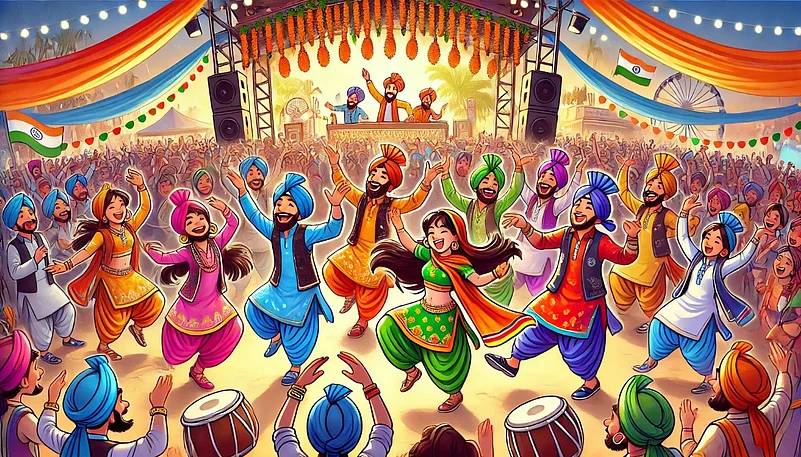The Punjab region of India observes Baisakhi as a major spring festival during agricultural harvest times, which combines cultural traditions with religious customs. The vivid folk dances Bhangra and Gidda fuel Baisakhi festivities because they demonstrate how Punjab people express joyful pride for their culture through their vibrant public dances. During Baisakhi celebrations, the traditional dances function as the main heartbeat while representing the essence of this cultural festival.
Origins in the Fields:
The Punjab region gave birth to the traditional dances of Bhangra and Giddha when the 1800s began. These dances originated from the region라이브 바카라 rural farming traditions. Farmers first introduced the tradition during Baisakhi to honor their labor after a bountiful harvest during the annual agricultural cycles. These dances display agricultural tasks through their body movements so people can exhibit their bond with the land they cultivate.
Bhangra: The Energetic Dance of Men
Bhangra is traditionally a male-dominated dance known for its high energy and vigorous movements. It is characterized by:
Powerful Movements: Bhangra involves dynamic actions like high kicks, leaps, jumps, and rotations, all synchronized to the beat of the dhol, a large double-sided drum.
Rhythmic Music: The music of Bhangra is driven by the dhol, creating a fast-paced and infectious rhythm. Often, short, lyrical songs called "boliyan" accompany the dance, expressing themes of love, patriotism, strength, and celebration.
Vibrant Attire: Bhangra dancers typically wear bright, colorful outfits called "vardiyaan," which include a kurta (long shirt), a tehmat or a lungi (a type of wraparound cloth), and a turban, often decorated with tassels. These costumes are not just for show; they enhance the visual impact of the energetic movements.
Evolution and Innovation: While rooted in tradition, Bhangra has evolved over time. It has incorporated elements from other Punjabi dances like Jhummar and Luddi and has also been influenced by Western styles, including hip-hop and reggae. This fusion has expanded its appeal and made it a popular dance form globally.
Giddha: The Graceful Dance of Women
Giddha is the female counterpart to Bhangra, a folk dance that is as energetic as it is graceful. It is traditionally performed by women and is characterized by:
Feminine Grace: While Bhangra emphasizes power, Giddha showcases feminine grace, elegance, and flexibility. The movements include rhythmic clapping, spinning, and delicate hand gestures.
Storytelling Through Song: Giddha is accompanied by "boliyan," folk songs that are often sung by the women themselves. These songs narrate stories of daily life, love, and the experiences of Punjabi women.
Circular Formation: Giddha is typically performed in a circle, with one woman often sitting in the center playing the dholki (a smaller drum). This formation emphasizes the sense of community and togetherness.
Colorful Costumes: Giddha dancers wear vibrant and colorful traditional Punjabi attire, such as a kameez (long shirt), salwar (loose trousers), or lehenga (skirt), and a dupatta (scarf), along with traditional jewelry.
Baisakhi: The Perfect Stage
During Baisakhi, Bhangra and Giddha take center stage as an integral part of the festivities. The dances are performed in:
Processions: During "Nagar Kirtan" processions, dancers perform Bhangra and Giddha, adding to the festive atmosphere.
Community Gatherings: At community feasts, families and friends come together and dance, showcasing the joyful spirit of the festival.
Fairs and Melas: Baisakhi fairs and melas feature live performances of both Bhangra and Giddha, entertaining crowds and drawing everyone into the celebratory spirit.
Gurdwaras: These dances are also performed as part of the cultural events at Gurdwaras (Sikh temples), connecting them to the religious significance of the festival.
More than just dance
The cultural significance of Bhangra and Giddha extends beyond mere entertainment:
Cultural Identity: They are an essential part of Punjabi identity, representing the traditions, heritage, and history of the region.
Community Bonding: The dances promote a sense of community and togetherness, bringing people from all walks of life to participate and celebrate together.
Expression of Emotion: Bhangra and Giddha are expressions of joy, hope, and gratitude, embodying the positive spirit of Baisakhi.
Global Influence: With the Punjabi diaspora spread worldwide, these dances have gained international recognition, integrating into various cultural settings.
Bhangra and Giddha operate as cultural performances that transmit essential Baisakhi festival messages through the hearts of dancers. Bhangra drum patterns combined with the fluid Giddha dance movements express both the celebration and historical heritage of Punjab during the harvest festival. During Baisakhi, these dances maintain their presence each year to keep spreading the festive rhythms that remind everyone about the festival's vital spirit.
Follow 바카라 Experiences:
| | |














